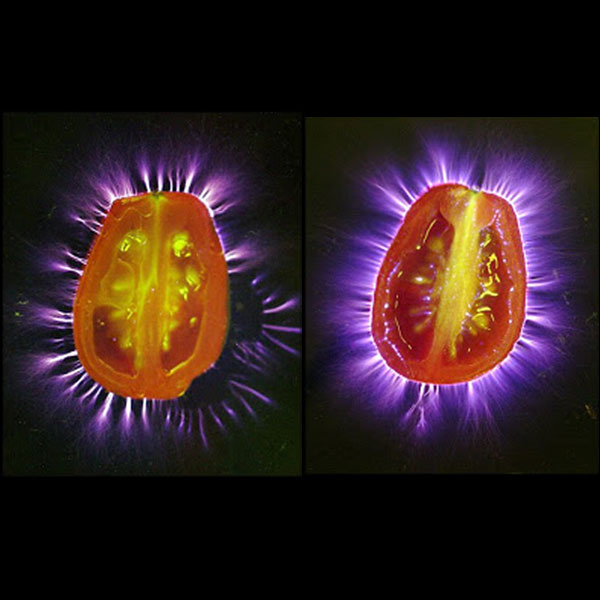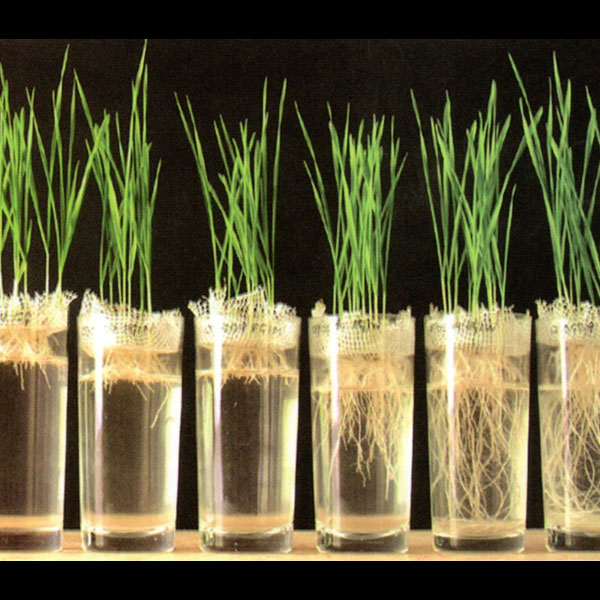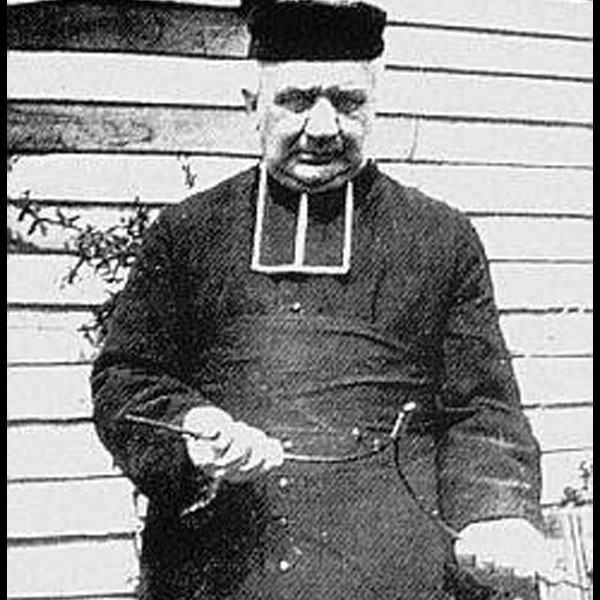
How to measure the vitality of a product
and the effect of MIRON glass?
For more than 25 years MIRON has been supporting thousands of customers to better preserve their natural products through the properties of violet glass. However, the history of violet glass goes way further back, to the time of the Egyptians who used violet glasses and gold jars to store their valuable medicines and cosmetics. We may all be convinced of the positive effect of violet glass, with the modern zeitgeist we are looking for more tangible proof as well. Visualization techniques make this possible so that we can better understand the working of our product.
Plants use the energy of sunlight to ‘feed’ themselves and produce antioxidants to protect themselves against harmful environmental influences. This ‘stored life energy’ is what makes natural products better for us than overly processed products. As harvesting and further processing breaks this optimal state, and the product will lose its energy and nutritional value over time. MIRON glass slows down this decaying process and even revitalizes the products stored inside. So, when we talk about the vitality of products, we mean the quality and degree of ‘life energy’ that the products possess over time. But how can we visualize or measure it?
Ir. Frank Silvis, a Dutch scientist who specializes in the vitalizing effects of water, has researched this topic for over 10 years. Last month he visited our MIRON headquarters and shared his rich experience and interesting results with us. This kind of research is still in its infancy and in full development. Besides simply testing a product in MIRON glass vs other packaging material and use sensory perception, Mr. Silvis explained four alternative methodologies that can measure the vitality of a product.

One visualization method is called Kirlian photography. An object is placed in a dark room on a light-sensitive piece of photo paper and photographed with a high voltage field. The object is thus exposed to a strong electric field of over 1,000 volts. This event ionizes the (gas) molecules present and creates small, faintly visible, colored discharges around the object. These are registered by the photo paper. Many different products have been photographed with this technique. It seems that vital products show more radiance or a glow in the photo around the product than less vital or processed products. This technique makes the invisible visible to the human eye.
A different method is looking at cause and effect, e.g. biological germ testing. This experiment looks at how nature reacts to water from different sources. The same plants are cultivated on, for example, sewage water, tap water, and surface water, and it is examined how this influences the growth process of the plants. Plants that received the most vital water grew best and those that received water with low vitality had difficulty growing. To test the effect of MIRON, use water from the same source and keep half in MIRON glass and the other half in other packaging solution. After a while, you set up the same test and let plants grow on the regular water and water that was stored in MIRON glass.


Crystallisation techniques, e.g. in the work of Masaru Emoto or in Soyana’s LifevisionLab, show, on a microscopic level, differences between vital and less vital products. For example, it turns out that vital products show 'more beautiful' and more symmetrical crystal formations. Simply put, processed products look chaotic at the microscopic level with natural products appearing more balanced. In addition, research also showed that environmental factors such as noise, electromagnetic fields, and even the texts on the labels of the bottles influence the crystals. And despite the same circumstances every crystal formation is unique, which makes it hard to replicate test results precisely. Despite this fact, the main conclusion remains, vital products look on a microscopic level more balanced and healthier.
The most intriguing methods are biophysical in nature: biophoton emissions, researched a.o. by Prof. Popp and Prof. Niggli, and energy contents research by a.o. André Bovis. In the 1930s, the field of radiesthesia or dowsing emerged, in which in the past people could flawlessly track down water sources out in the field or even on maps using a dowsing rod. These rods change in direction of a pendulum, supposedly in response to unseen influences or radiation. This technique can also be applied to measure the vitality of a product. The rods are reacting to the degree of vitality of the product which can be plotted on a normal distribution scale. This result can be referred to as the so-called Bovis score.
The Frenchman André Bovis has developed the bovis scale to increase the vitality of people and foods. He did this because he was looking for an accurate, yet simple, method for determining the quality of foodstuffs, with which he was professionally engaged. He assumed that all matter emits radiation. The frequency / wavelength of this radiation, he believed to be able to measure. He made a scale and could, by a pendulum, over this scale to move, read the value of the measured product. Bovis called his instrument the 'biometer', which became a great success. After the second World War the method of Bovis was further elaborated by the physicist Simonéton and the result of the scale division is from that time called 'Bovis value'. Healthy people have a value from 6500 to 8000 on the Bovis scale. Therefore, in order to stay healthy, man needs food consuming more than 6,500 Bovis. Many foods (especially overly processed food) do not reach this value and therefore diminish the human life force, instead of adding anything to it.
Ir. Frank Silvis has measured many products in his career and has found that unprocessed natural products have a much higher Bovis score than processed food and drinks. In addition, Frank Silvis' test results show that the Bovis score decreases over time as the products start to decay. Strikingly enough, the Bovis value of products increases over time when they are packaged in MIRON glass. This test also shows that MIRON glass significantly slows down the decay process and therefore better preserving natural products. There are exceptions to the rule, e.g. quick perishable items like milk or fruit seem to have a shorter shelf life in MIRON glass. It seems that products that naturally have a longer shelf life than just a few days are protected extra well in MIRON glass and the other way around. Because every product reacts differently to violet glass, we always recommend testing your own products yourself, using our sample bottles or jars.

To conclude, there are different methods to make the invisible visible and to observe positive differences between natural products that have been stored in MIRON glass compared to other packaging solutions. Are you curious what the reason is that MIRON glass protects natural products well? Learn more about violet glass on this page.
